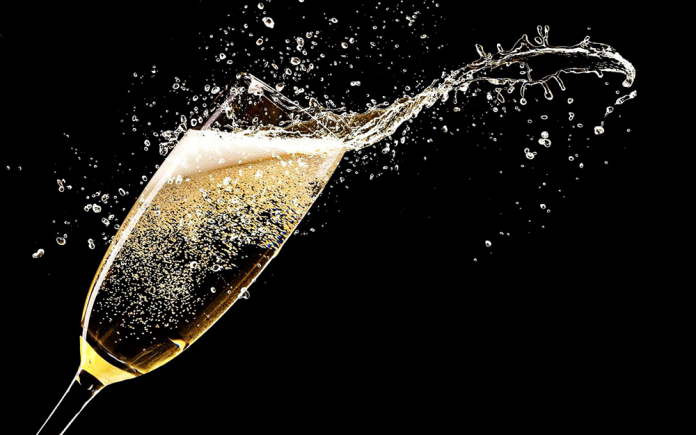
By Rick Riozza
Whoever coined the phrase, “Time marchers on!” was right on! Half the year of 2022 already passed last month! And not only in our desert, but with climate change, the whole world is hot, hot, hot.
We wine enthusiasts often find relief at these times with a fine chilled glass of sparkles. And life is easy for us, for we don’t necessarily have to shell out the really big bucks to taste some fantastic sparkling wine. California surely produces world-class bubbly and we can find most of the stuff at our supermarkets at any time. Cheers to that!
One of our most favorite California sparklers that we recommend regularly is Roederer Estate. And I don’t think we’ve taken the time to enlighten our readership to the unique California history of this wine. As you would expect, there is a fun French/California connection that explains how & why the brand has produced premium sparkles for the past 40 years.
Many of us venerable vino heads will remember the onslaught of French Champagne companies coming to California to enjoy the climate and the expanse of vineyard available in the northern part of the state. Names like Mumm, Tattinger, Moet & Chandon all came a’callin when the French wine economists figured out that California was the place you oughta be, so they loaded up their trucks and moved to Napoli—err, rather, just Napa.
Of course, the famed Champagne Houses did not move from France, but they founded a new champagne outpost in California wine country. These vintners planted in the beautiful and inviting Napa County; however, the Champagne house of Louis Roederer shunned Napa/Sonoma and headed instead for the cool slopes of Mendocino’s Anderson Valley. The valley offered well-drained and gravel soils, lots of fog from the nearby Pacific Ocean, and really cool nights. Wine critic Tim Fish recently commented, “Now, as the winery marks its 40th anniversary, it’s clear Anderson Valley was the wise choice.”
The winery was established in 1982 and the estate vines were planted in 1984 with the vision to make sparkling wine in Champagne’s image by not only following century-old traditional processes but adhering to the philosophy of the parent company’s strict rules with blends and aging. Today there are 624 acres of estate vineyards, a mix of 55% Pinot Noir and 45% Chardonnay.
Ask your average French Champagne lover, “Which California sparkling wine comes close to their French counterpart?” The answer usually given is Roederer Estate.
From among the Roederer Estate’s portfolio, the two sparklers we write often on, and that are available at most supermakets, are the L’Ermitage Brut and the Brut Multi-vintage.
The Roederer Estate Brut $30, is always crisp and elegant with complex pear, spice and hazelnut flavors. It is fresh and lightly fruity with great finesse and depth of flavor.
James Suckling recently reviewed the wine, stating, “Extremely fresh and floral with sliced apples, stones and some white peach, bread dough, too. Medium to full body with crisp acidity and a steely finish. Hints of phenolics provide a fine wine texture. Vibrant acidity. About 15% reserve wine (mostly chardonnay) from five vintages. 2.5 years on the lees. 60% Chardonnay and 40% Pinot Noir. Drink or hold.”
L’Ermitage, Roederer Estate’s special Tête de Cuvée, $60, is a sparkling wine made only in exceptional years from pre-selected, estate-grown grapes. Carrying on the tradition of Champagne Louis Roederer in France, Roederer Estate produces its sparkling wines in the traditional French méthode traditionelle and adds special oak-aged reserve wines to each blend. L’Ermitage debuted with the 1989 vintage.
John Gilman in his View from the Cellar writes, “I know that there are a lot of extremely good sparkling wines now made in the United States, but to my palate, the Roederer Estate “l’Ermitage” bottling is the finest. The 2015 vintage of this excellent wine is composed of a cépages of fifty-two percent chardonnay and forty-eight percent pinot noir. It was finished with a dosage of eight grams per liter in this vintage.
The wine delivers a superb and very refined bouquet of tart pear, apple, fresh-baked bread, a complex base of soil, discreet smokiness and a top note of dried flowers. On the palate the wine is deep, young, full-bodied and very elegant in profile, with a lovely core, excellent soil signature, bright acids, extremely elegant mousse and a long, complex and beautifully balanced finish. This is so seamlessly balanced that it is already drinking very well at six years of age, but it has the potential to blossom and improve with bottle age and I would love to drink it a decade down the road! The 2015 is clearly a very, very special vintage for the l’Ermitage bottling at Roederer Estate!”
Another sparkler favorite of this column is Schramsberg Vineyards, in particular the Schramsberg Blanc de Blancs $40. I remember back in the day, meeting and chatting with Jack and Jamie Davies, the founding owners of Schramsberg, over at the Sycamore Inn in Rancho Cucamonga. There they were pouring their latest sparkling wines, with the Blanc de Blancs being the best of the pouring. I also met their son Hugh, who is now the winery’s vintner.
Inspired by the French, Jack and Jamie Davies set out in 1965 to make the first commercial Pinot Noir and Chardonnay based sparkling wines using méthode Champenoise in the United States. They traveled to Champagne many times to compare notes with top producers such as Louis Roederer, Bollinger and Pol Roger.
The Schramsberg style of Blanc de Blancs is dry and crisp. The Blanc de Blancs was the first sparkler the Napa Valley winery produced, and it gained international recognition in 1972 when then-President Richard Nixon served the wine at the historic “Toast to Peace” in Beijing, China.
Here’s to sparkles! Cheers!










































